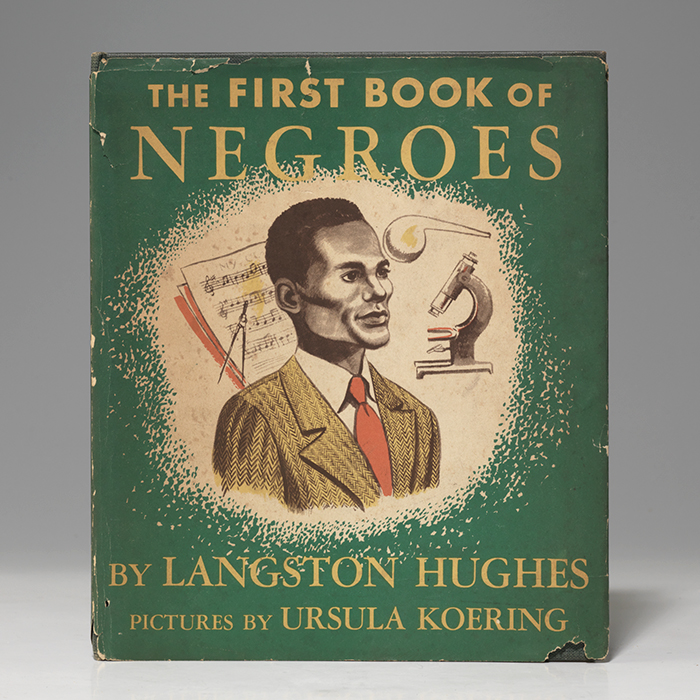
"A DEEP SENSE OF HISTORY, IDENTITY AND PLACE": EXCEEDINGLY SCARCE PRESENTATION/ASSOCIATION FIRST EDITION, FIRST PRINTING, OF LANGSTON HUGHES' LANDMARK WORK IN HIS FIVE-VOLUME SERIES FOR CHILDREN, THE FIRST BOOK OF NEGROES, 1952, INSCRIBED BY HIM IN THE YEAR OF PUBLICATION TO HIS COUSIN
HUGHES, Langston. The First Book of Negroes. New York: Franklin Watts, 1952. Square quarto, original gilt-stamped green cloth, pictorial endpapers, original pictorial dust jacket. $3200.
First edition of Hughes' inaugural book in his major five-volume series on black history from the 16th century to Jim Crow America, the highly elusive first printing issued at the height of McCarthyism with Josephine Baker's image and biography that was quickly omitted from subsequent printings, a very scarce presentation/association copy inscribed by Hughes on the title page in the year of publication, "For my Cousin Pet—Sincerely—Langston, New York, Oct. 10, 1952," an exceptional copy in the colorful unrestored dust jacket.
Here, in the first book of Hughes' five-volume series for children, he "kept clearly in mind the idea that his readers would, more than likely, be the ones to confront their nation's greatest failure of its democracy, the racial divide, head on. So he wrote in First Book of Negroes (1952) of the noble history of Africans and of the diverse and significant achievements of one African American after another" (Clark, Civics of Getting Along, 8). Written in the form of stories told to a fictional African American boy named Terry, the book was issued two years before the landmark Brown v. Board of Education decision. Terry and the other children in this pioneering work "are both shaped by and come to terms with race politics at once… It can be easy to dismiss the political importance of these messages over 60 years later… To do so, however, is to misread the importance of First Book of Negroes as well as its continually adaptive writer, who sought to bring central, long-developing principles of political rights and aesthetic representation to some of the nation's youngest and most impressionable citizens… In his early work Hughes had often conceived of Africa, as did other Harlem Renaissance writers, as a symbolic motherland… In First Book of Negroes, by contrast, he is more interested in African resistance to European colonialism… and the flourishing of African civilization before European colonization." The book's further assessment of Jim Crow, and Hughes' focus on a black child in Harlem underlines his conviction that African American "achievement was compatible with a deep sense of history, identity and place. Owning and telling this history, in literature and in lore, was key to the process” (Erickson & Morrell, eds, Educating Harlem).
This exceedingly scarce presentation/association copy is notably inscribed by Hughes only five months before he was compelled to defend himself in the Joseph McCarthy hearings. It is, as well, a highly elusive first printing—one that contains the image and a short biography of Josephine Baker. These were excised when "a New York columnist threatened to attack the book unless all references to her were removed—on the grounds that Baker was a communist—she disappeared from the text in the next printing'" (Rampersad in Bloom, ed., Langston Hughes, 215). In addition, the book was published with no references to either W.E.B. Du Bois or Paul Robeson. In 1965 Hughes spoke of the politics behind that omission: "It was at the height of the McCarthy Red-baiting era, and publishers had to go out of their way to keep books, particularly children's books, from being attacked, as well as schools and libraries that might purchase books… it was impossible at that time to get anything into children's books about either Dr. Du Bois or Paul Robeson" (Rampersad II, 230-31). With "First Printing" stated opposite title page; containing image and biography of Josephine Baker (45). With color and black-and-white illustrations by Ursula Koering, many full- and double-page. The identity of Hughes' "Cousin Pet" is undetermined.
Book fine; with bit of edge-wear, chipping to spine ends minimally affecting lettering of colorful, very good dust jacket.